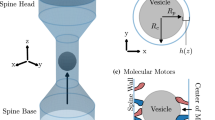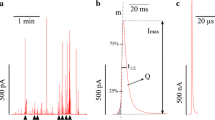Abstract
Neurosecretory cells spatially redistribute their pool of secretory vesicles upon stimulation. Recent observations suggest that in chromaffin cells vesicles move either freely or in a directed fashion by what appears to be a conveyor belt mechanism. We suggest that this observation reflects the transient active transport through molecular motors along cytoskeleton fibres and quantify this effect using a 1D mathematical model that couples a diffusion equation to advection equations. In agreement with recent observations the model predicts that random motion dominates towards the cell centre whereas directed motion prevails in the region abutting the cortical membrane. Furthermore the model explains the observed bias of directed transport towards the periphery upon stimulation. Our model suggests that even if vesicle transport is indifferent with respect to direction, stimulation creates a gradient of free vesicles at first and this triggers the bias of transport in forward direction. Using matched asymptotic expansion we derive an approximate drift-diffusion type model that is capable of quantifying this effect. Based on this model we compute the characteristic time for the system to adapt to stimulation and we identify a Michaelis–Menten-type law describing the flux of vesicles entering the pathway to exocytosis.







Similar content being viewed by others
References
Barlan K, Gelfand VI (2017) Microtubule-based transport and the distribution, tethering, and organization of organelles. Cold Spring Harbor Perspect Biol. https://doi.org/10.1101/cshperspect.a025817
Birbaumer M, Schweitzer F (2011) Agent-based modeling of intracellular transport. Eur Phys J B 82:245
Bressloff PC (2014) Stochastic processes in cell biology, vol 41. Springer, Berlin
Brown SS (1999) Cooperation between microtubule- and actin-based motor proteins. Ann Rev Cell Dev Biol 15(1):63–80. https://doi.org/10.1146/annurev.cellbio.15.1.63
Caviston JP, Holzbaur EL (2006) Microtubule motors at the intersection of trafficking and transport. Trends Cell Biol 16(10):530–537. https://doi.org/10.1016/j.tcb.2006.08.002.MembraneDynamics
Chen W, Zhou W, Xia T, Gu X (2012) A computational analysis framework for molecular cell dynamics: case-study of exocytosis. PLoS ONE 7(7):1–10. https://doi.org/10.1371/journal.pone.0038699
Gimenez-Molina Y, Villanueva J, Francés M.d.M, Viniegra S, Gutiérrez L.M. (2018) Multiple mechanisms driving f-actin-dependent transport of organelles to and from secretory sites in bovine chromaffin cells. Front Cell Neurosci 12:344. https://doi.org/10.3389/fncel.2018.00344
Giner D, López I, Villanueva J, Torres V, Viniegra S, Gutiérrez LM (2007) Vesicle movements are governed by the size and dynamics of f-actin cytoskeletal structures in bovine chromaffin cells. Neuroscience 146(2):659–669. https://doi.org/10.1016/j.neuroscience.2007.02.039
Gutiérrez LM, Villanueva J (2018) The role of F-actin in the transport and secretion of chromaffin granules: an historic perspective. Pflügers Archiv Eur J Physiol 470(1):181–186
Hadeler KP (2017) Topics in mathematical biology by Karl Peter Hadeler. Lecture notes on mathematical modelling in the life sciences. Springer International Publishing, Springer, Cham
Holmes MH (2012) Introduction to perturbation methods. Texts in applied mathematics. Springer, New York
Jarukanont D, Bonifas Arredondo I, Femat R, Garcia ME (2015) Vesicle motion during sustained exocytosis in chromaffin cells: numerical model based on amperometric measurements. PLoS ONE 10(12):1–25. https://doi.org/10.1371/journal.pone.0144045
KAC M (1974) A stochastic model related to the telegrapher’s equation. Rocky Mt J Math 4(3):497–509
Klann M, Koeppl H, Reuss M (2012) Spatial modeling of vesicle transport and the cytoskeleton: the challenge of hitting the right road. PLoS ONE 7(1):1–15. https://doi.org/10.1371/journal.pone.0029645
Maucort G, Kasula R, Papadopulos A, Nieminen TA, Rubinsztein-Dunlop H, Meunier FA (2014) Mapping organelle motion reveals a vesicular conveyor belt spatially replenishing secretory vesicles in stimulated chromaffin cells. PLoS ONE 9(1):1–9. https://doi.org/10.1371/journal.pone.0087242
Mayorga LS, Verma M, Hontecillas R, Hoops S, Bassaganya-Riera J (2017) Agents and networks to model the dynamic interactions of intracellular transport. Cell Logist 7(4):e1392401. https://doi.org/10.1080/21592799.2017.1392401
Neco P, Giner D, Del Mar Francés M, Viniegra S, Gutiérrez LM (2003) Differential participation of actin- and tubulin-based vesicle transport systems during secretion in bovine chromaffin cells. Eur J Neurosci 18(4):733–742. https://doi.org/10.1046/j.1460-9568.2003.02801.x
Newby JM, Bressloff PC (2010) Quasi-steady state reduction of molecular motor-based models of directed intermittent search. Bull Math Biol 72(7):1840–1866
Oelz D, Mogilner A (2016) A drift-diffusion model for molecular motor transport in anisotropic filament bundles. Discrete Cont Dyn Syst A 36(8):4553–67. https://doi.org/10.3934/dcds.2016.36.4553
Oheim M, Stühmer W (2000) Tracking chromaffin granules on their way through the actin cortex. Eur Biophys J 29(2):67–89
Rosé SD, Lejen T, Casaletti L, Larson RE, Pene TD, Trifaró JM (2003) Myosins II and V in chromaffin cells: myosin V is a chromaffin vesicle molecular motor involved in secretion. J Neurochem 85(2):287–298. https://doi.org/10.1046/j.1471-4159.2003.01649.x
Rudolf R, Kögel T, Kuznetsov SA, Salm T, Schlicker O, Hellwig A, Hammer JA, Gerdes HH (2003) Myosin va facilitates the distribution of secretory granules in the f-actin rich cortex of pc12 cells. J Cell Sci 116(7):1339–1348. https://doi.org/10.1242/jcs.00317
Smith D, Simmons R (2001) Models of motor-assisted transport of intracellular particles. Biophys J 80(1):45–68. https://doi.org/10.1016/S0006-3495(01)75994-2
Trifaró JM, Bader MF, Doucet JP (1985) Chromaffin cell cytoskeleton: its possible role in secretion. Can J Biochem Cell Biol 63(6):661–679. https://doi.org/10.1139/o85-084
Trifaró JM, Gasman S, Gutiérrez LM (2008) Cytoskeletal control of vesicle transport and exocytosis in chromaffin cells. Acta Physiol 192(2):165–172. https://doi.org/10.1111/j.1748-1716.2007.01808.x
White D, de Vries G, Dawes A (2014) Microtubule patterning in the presence of stationary motor distributions. Bull Math Biol 76(8):1917–1940
Zhang XW, Hatamie A, Ewing AG (2020) Simultaneous quantification of vesicle size and catecholamine content by resistive pulses in nanopores and vesicle impact electrochemical cytometry. J Am Chem Soc 142(9):4093–4097. https://doi.org/10.1021/jacs.9b13221 (PMID: 32069039)
Acknowledgements
The author wants is thankful for valuable discussions with Calvin Zhang (U. of Arizona), Elaine Schenk (UQ) and Frederic Meunier (UQ).
Author information
Authors and Affiliations
Corresponding author
Additional information
Publisher's Note
Springer Nature remains neutral with regard to jurisdictional claims in published maps and institutional affiliations.
DO was supported by ARC Discovery Project DP180102956.
Appendices
Inner problem
Equating terms of equal order in (6) we find the following equations relating terms in the expansions of c, f and g.
\(O\left( \varepsilon ^{-2} \right) \): We find that
i.e. the ratio of the leading order terms, free vesicles versus transported vesicles, is fixed and at the leading order the differential term vanishes.
\(O\left( \varepsilon ^{-1} \right) \): Equating terms of order \(\varepsilon ^{-1}\), the differential term at first order is given by
and the ratio of free vesicles versus transported ones is given by \(\alpha \) even at first order since
where we used (37).
O(1): From the first two systems in (6) we obtain
which implies, taking the sum and using (36) and (38), that
From the third system in (6) we obtain
where we used (37). Finally, (40) combined with (42) shows that
\(O(\varepsilon )\): Likewise, taking the sum of the \(O(\varepsilon )\) terms in the equations for c and f in (6) and using (39) and (43) we obtain
Left boundary layer
We focus on an expansion up to leading order only, i.e. \(c \approx \bar{c}_0 + O(\varepsilon )\), \(f \approx \bar{f}_0 + O(\varepsilon )\) and \(g \approx \bar{g}_0 + O(\varepsilon )\), and obtain
with boundary conditions
Taking a derivative of (48) and coupling with (47) and (46) respectively, we find that \( -a^2 \bar{f}_0'' = a \bar{g}_0' = \alpha \bar{c}_0-\bar{f}_0=\bar{c}_0''\). Hence \(-a^2 \bar{f}_0=\bar{c}_0 + A x+B\) for two constants A and B. Since in the far field (\(\bar{x} \rightarrow \infty \)) we expect that the following matching conditions hold, \(\bar{c}_0(t, \bar{x}) \rightarrow c_0(t, x=0)\) and, as a consequence of (36), \(\bar{f}_0 (t, \bar{x}) \rightarrow \alpha c_0(t, x=0)\) we obtain \(A=0\) and \( -a^2 \alpha c_0(0) =c_0(0) +B \), i.e. \(B=- c_0(0) (1+\alpha a^2)\).
From this we conclude \( \bar{f}_0(t, \bar{x})= \frac{-1}{a^2} \left( \bar{c}_0(t, \bar{x}) - c_0(t, 0) (1+\alpha a^2) \right) \) which we substitute in (46) to obtain an equation for \(\bar{c}_0\),
Coupling this with (50) we obtain
and
We determine the far field \(c_0(t, 0)\) so that (49) is satisfied, i.e. \(0= (1-c_0(t, 0)) - c_0(t, 0) \alpha a^2 + (1-c_0(t, 0)) \sqrt{\alpha a^2 + 1} \) and conclude that
where K is defined in (14) and represents the ratio between \(c_0(t, 0)\) and the actual boundary value \(\bar{c}_0(t, 0)\) for every \(t>0\).
Right boundary layer
The system (6) written with respect to the right boundary layer variables \(\hat{c}\), \(\hat{f}\), \(\hat{g}\) and \(\hat{x}\) is given by (15), coupled to the boundary conditions (16) and (17). The leading order terms in the expansion \(\hat{c} \approx \hat{c}_0 + O(\varepsilon )\), \(\hat{f} \approx \hat{f}_0 + O(\varepsilon )\) and \(\hat{g} \approx \hat{g}_0 + O(\varepsilon )\) satisfy the system of equations
as well as the boundary conditions
Using Eqs. (53), (52) and (51) we obtain \(-a^2 \hat{f}_0'' = a \hat{g}_0' = \alpha \hat{c}_0-\hat{f}_0=\hat{c}_0''\). Hence, for two arbitrary constants A and B it holds that \(-a^2 \hat{f}_0=\hat{c}_0 + A x+B\). It is our goal to match the solution of the right boundary layer problem to the solution to the inner problem, therefore we expect that in the far field \(\hat{x} \rightarrow -\infty \) it holds that \(\hat{f}_0(t, \hat{x})=f_0(t, 1) = \alpha c_0(t, 1)\) where we used (36). Therefore we find that \(A=0\) and \(B=- c_0(1) (1+\alpha a^2)\). As a consequence it holds that
which we substitute in (51) to obtain
Coupling this to the matching condition \(\lim _{\hat{x} \rightarrow -\infty } \hat{c}_0(t, \hat{x})=c_0(t, 1)\) we obtain
for a constant \(\hat{K}\). Substituting (57) in (56) we also find
The constant \(\hat{K}\) can be determined by coupling these results to either (54) or (55). Substituting (57) and (58) in (55) we find that
which implies
which equals the constant of proportionality K we found before for the left boundary layer. Note that coupling (57), (56) with (54) instead leads to the same result according to computations which mimic those to find K in the left boundary layer: First substitute (58) in (53) to find
which, together with (58), we substitute in (54) to obtain
which leads to (59).
Rights and permissions
About this article
Cite this article
Oelz, D.B. Quasi-steady-state reduction of a model for cytoplasmic transport of secretory vesicles in stimulated chromaffin cells. J. Math. Biol. 82, 29 (2021). https://doi.org/10.1007/s00285-021-01583-5
Received:
Revised:
Accepted:
Published:
DOI: https://doi.org/10.1007/s00285-021-01583-5




